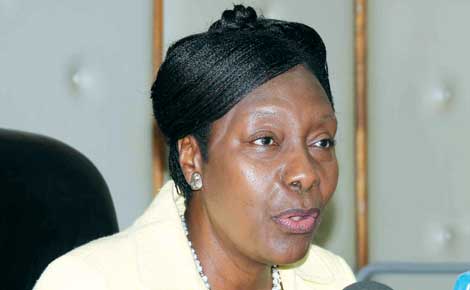 |
|
Lands Cabinet Secretary Charity Ngilu. (Photo:File/Standard) |
By F T Odhiambo
Kenya: The never-ending supremacy battles between Lands Cabinet Secretary Charity Ngilu and Chairman of the National Land Commission Mohammed Swazuri have slowed down land reforms.
This negates the Jubilees administration manifesto’s pledge of repossession of all illegally occupied land, prosecution of land grabbers and acceleration of issuance of title deeds to enable sustainable use of land.
A random check across the country reveals a big disparity in socio-economic and infrastructure development, with titled areas recording much progress and untitled areas lagging behind. Apart from land registration guaranteeing and protecting rights and interests of individuals thus improving access to credit, services and predictability of land markets, it also accelerates infrastructure planning and protection of the environment within local communities and helping in poverty alleviation.
Development acceleration
To accelerate development countrywide, the Government has issued title deeds to areas hitherto unregistered and plans to issue one million title deeds by the end of 2014. To achieve this, a simple calculation reveals that 4,000 title deeds must be prepared every day for newly registered areas. This crash programme requires about 40 land registrars, 50 filing clerks and 100 copy typists to prepare land registers and title deeds every day.
And this is not to forget that numerous other land transactions such as transfers, charges, leases, succession and partition are equally important to drive the economy forward.
Theoretically, it is possible to issue one million title deeds a year for newly registered areas on assumption that all the due process in land adjudication has been completed over the past several years and that what remains is the issuance of title deeds.
But this is impossible if in areas where land adjudication, demarcation, mapping and registration have not been carried out or completed. This is because these are long processes, which take years to accomplish, assuming appeals and objections are few, and might stretch several more years if there are many objections, appeals and counter-claims.
Acquiring title deeds
Title deeds are documents showing ownership of rights and interests in land. Due to their sanctity, they should be foolproof. Titles can be obtained by either primary or secondary methods. Secondary methods are through transfer by way of valuable consideration, gift, succession or statutory sale. Primary methods of obtaining title deeds can be through Government allocations or allotment of land.
The major primary methods of obtaining a title deed is through first registration during land adjudication process where rights and interests in ancestral lands are claimed, recorded and registered. The titles are issued on the strength of land register based on preliminary index diagrams, or registry index maps (RIMs).
Land adjudication process
Land adjudication involves several sectors and personnel, starting with the local people, local administration, and Ministry of Land, legal, paralegal and technical staff. By the time a title deed is being issued, it will have undergone numerous complex processes, which encompass both field and office work.
Land adjudication commences with the appointment of adjudication officer, his staff, adjudication committee and arbitration board, which is then gazetted.
Stay informed. Subscribe to our newsletter
The adjudication section is established and its area defined. It is then declared that interest in land within the section will be ascertained and recorded, giving sufficient notice for claims and demarcation of boundaries.
Aerial photography of the area is done and enlarged aerial photographs prepared for boundary determination. A survey officer prepares demarcation maps showing every parcel of land identified by a distinguished number.
The demarcation maps, which are preliminary index diagrams (PIDs), are produced and field queries done if any arises. Any complaint should be directed to the executive committee, which can also reach the arbitration board.
The PIDs can be upgraded to RIMs by re-flying the adjudication section, preparing machine plots and solving any re-fly queries. The RIMs are superior and more accurate than PIDs. The demarcation map and adjudication records form the adjudication register.
Sufficient period is given for inspection of the register and any objection raised within 60 days of notice. Appeals should also be made within 60 days of determination of objections to the Lands Cabinet Secretary.
Once the adjudication register is declared final, it is handed to chief land registrar to prepare land register and issue title deeds, while Survey of Kenya prepares the final cadastral maps. The cadastral maps and the land register support the title deed and form the cadastre.
In order to have a good title deed, a thorough check and counter-check is done at every stage to minimise future disputes. Land adjudication requires thorough preparation and adequate funding. It might take a minimum of three years to complete a small adjudication section if all data is available and claimants have minimal disputes.
Areas with numerous disputes and counter-claims can take longer periods of up to 40 years as witnessed in some parts of Kenya where adjudication work is yet to be finished.
So, will the target of one million title deeds annually be possible? To be able to meet this target in future, legislation should be made for private participation in land adjudication process. With the requirement of geo-referencing as stipulated in the Land Act 2012 and Land Registration Act 2012, the Government should facilitate access to affordable survey grade GPS instruments to enable geo-spatial engineers acquire the gadgets to enable acceleration of issuances of title deeds.
— The writer is a survey and mapping professional with Maptech Consult
 The Standard Group Plc is a
multi-media organization with investments in media platforms spanning newspaper
print operations, television, radio broadcasting, digital and online services. The
Standard Group is recognized as a leading multi-media house in Kenya with a key
influence in matters of national and international interest.
The Standard Group Plc is a
multi-media organization with investments in media platforms spanning newspaper
print operations, television, radio broadcasting, digital and online services. The
Standard Group is recognized as a leading multi-media house in Kenya with a key
influence in matters of national and international interest.
 The Standard Group Plc is a
multi-media organization with investments in media platforms spanning newspaper
print operations, television, radio broadcasting, digital and online services. The
Standard Group is recognized as a leading multi-media house in Kenya with a key
influence in matters of national and international interest.
The Standard Group Plc is a
multi-media organization with investments in media platforms spanning newspaper
print operations, television, radio broadcasting, digital and online services. The
Standard Group is recognized as a leading multi-media house in Kenya with a key
influence in matters of national and international interest.








